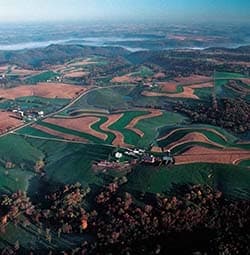Why Do Farmers Farm the Way They Do?
 Farmers must be masters of adaptation—they must cope with changing federal policies, fluctuating crop prices, and advancing technology. A new report from the Leopold Center for Sustainable Agriculture shows how farmers in northeast Iowa have adapted to change over the past 80 years.
Farmers must be masters of adaptation—they must cope with changing federal policies, fluctuating crop prices, and advancing technology. A new report from the Leopold Center for Sustainable Agriculture shows how farmers in northeast Iowa have adapted to change over the past 80 years.
Last summer, French researcher Alice Topaloff conducted a historical analysis of northeast Iowa’s food systems as part of her internship for the Leopold Center’s Marketing and Food Systems Initiative. She interviewed over 100 Iowans to investigate how farms came to look like they do today. Her case study examines the past in order to understand the existing agricultural landscape and to predict the current system’s resilience for the future.
Topaloff admits that before conducting her study, she shared the popular misconception that conventional agriculture is a homogenous and stagnant system. “But that’s not at all what I found,” she says. “I had to categorize all of the different types of farms, and just for corn/bean farms, I found six sub-models. They’re all so different. It was very simplistic to think that they would all be the same.”
The agricultural diversity Topaloff found in northeast Iowa can be explained by major historical events that forced farmers to adapt in order to stay competitive.
For example, laws regarding food sanitation, especially for dairy production, became stricter in the 1960s, which forced dairy farmers to either sell the herd and start cultivating a corn/bean rotation, or increase the size of the dairy herd while modernizing their operations. The decision farmers made was dictated by their resource base—whether labor or land was the limiting resource on the farm.
Geography also played a large role in determining how farmers respond to change. The 1980s Farm Crisis affected flatland and hillside farms differently. Farmers on the flatland faced more extreme alternatives—bankruptcy or dramatic expansion through the purchase of bankrupt farms. By contrast, hill-area hog farmers who depended exclusively on income from hog sales tended to abandon hog production and put their land into Conservation Reserve Program (CRP) contracts in response to the economic downturn, thus, preventing the farms from being put up for sale. This slowed down the movement toward bigger, fewer farms.
Topaloff’s report includes a decision tree that diagrams the patterns of farm evolution, beginning with two primary types of farms in 1945 and ending with 12 primary types of farms in 2013. The diagram illustrates a trend toward increased specialization and size.
A summary of Topaloff’s study is “Diversity of Conventional Farming in Northeast Iowa: Why Do Farmers Farm the Way They Do?” You can read it online at http://www.leopold.iastate.edu/pubs-and-papers/2014-04-diversity-conventional-farming-northeast-iowa.
Photo Credit: Aerial view of contour stripcropping and fog‐lined valleys in Winnneshiek County, Tim McCabe. 2011. Photo courtesy of USDA Natural Resources Conservation Service
Contact: Alice Topaloff, topaloff@iastate.edu, 515-294-8530


